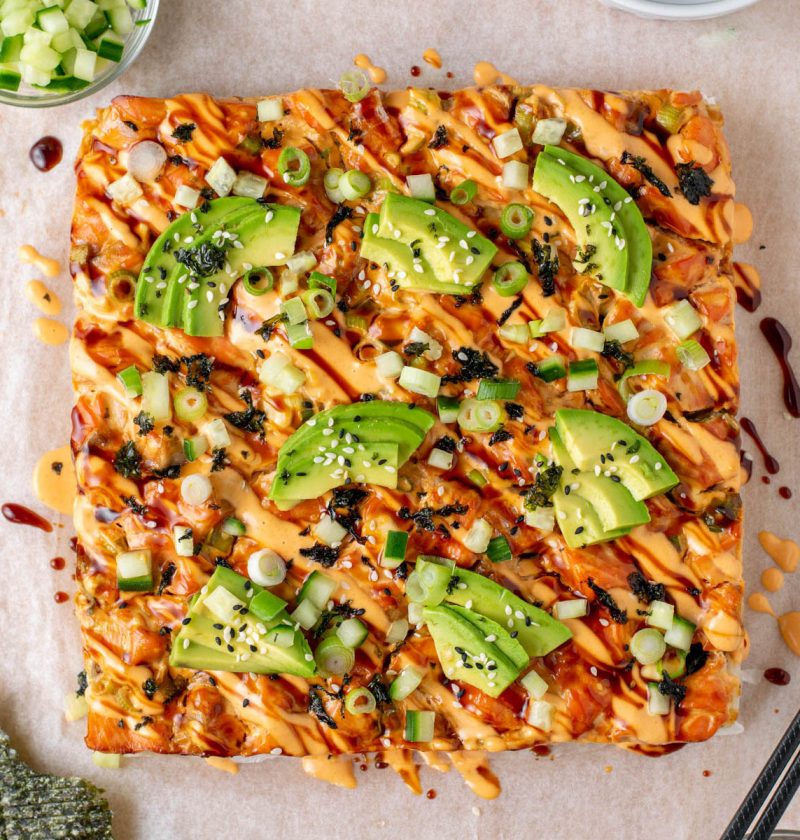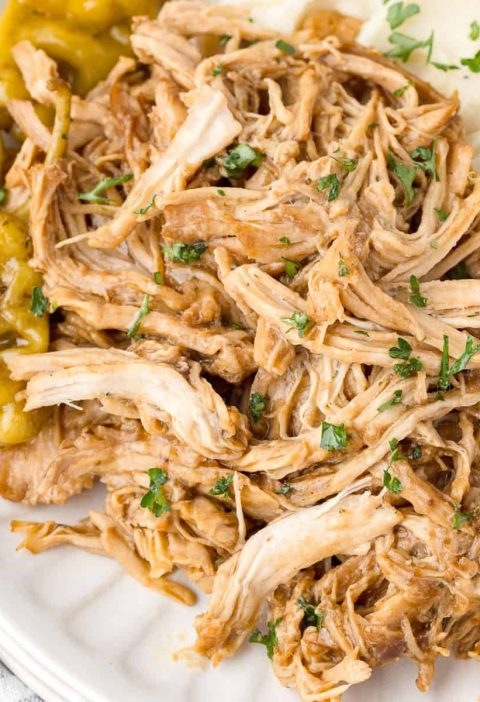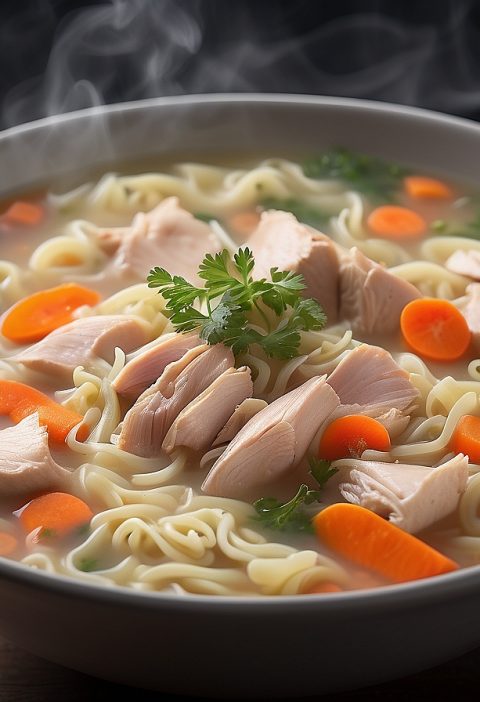Indulge in the irresistible fusion of flavors with our heavenly Salmon Sushi Bake. This delectable dish takes the beloved elements of sushi and transforms them into a warm, savory casserole that will leave your taste buds begging for more. With layers of succulent salmon, seasoned rice, creamy mayo, and a hint of spice, this recipe offers a delightful twist on traditional sushi rolls. Whether you’re a sushi lover or simply looking to try something new, this Salmon Sushi Bake is sure to impress!
- Difficulty: Moderate
- Prep Time: 20 minutes
- Cooking Time: 40 minutes
- Servings: 6
- Yield: 1 delicious casserole
- Calories: Approximately 400 calories per serving
Ingredients:
- 2 cups (400g) sushi rice
- 4 cups (960ml) water
- 1 1/2 pounds (680g) fresh salmon fillets, skinless
- 1/4 cup (60ml) soy sauce
- 2 tablespoons (30ml) rice vinegar
- 1 tablespoon (15g) white sugar
- 1/2 teaspoon (2.5g) salt
- 1/4 teaspoon (1.25g) black pepper
- 1 cup (240g) Japanese mayonnaise
- 1/4 cup (60ml) sriracha sauce
- 1/2 cup (60g) sliced green onions
- 1/4 cup (30g) toasted sesame seeds
Equipment:
- Large mixing bowl
- Fine-mesh sieve
- Medium saucepan
- Baking dish (9×13 inches or similar)
- Aluminum foil
Step-by-Step Guide:
Step 1
- Preheat your oven to 375°F (190°C).
- Rinse the sushi rice under cold water until the water runs clear.
- In a medium saucepan, combine the rinsed rice and water.
- Bring the mixture to a boil over high heat, then reduce the heat to low and cover the saucepan.
- Simmer for 15 minutes or until the rice is tender and the water is absorbed.
- Remove the saucepan from the heat and let it sit, covered, for an additional 10 minutes to allow the rice to steam.
Step 2
- While the rice is cooking, cut the salmon fillets into bite-sized pieces.
- In a small bowl, whisk together the soy sauce, rice vinegar, sugar, salt, and black pepper.
- Pour the marinade over the salmon pieces and toss gently to coat.
- Let the salmon marinate for 10 minutes to absorb the flavors.
Step 3
- Drain any excess liquid from the marinated salmon.
- In a separate bowl, combine the Japanese mayonnaise and sriracha sauce.
- Add the drained salmon to the mayo-sriracha mixture and stir until well coated.
Step 4
- In the prepared baking dish, spread half of the cooked sushi rice evenly as the base layer.
- Layer the marinated salmon on top of the rice, distributing it evenly.
- Spread the remaining sushi rice over the salmon layer, pressing gently to create a compact casserole.
- Cover the baking dish with aluminum foil.
Step 5
- Bake the Salmon Sushi Bake in the preheated oven for 20 minutes.
- Remove the foil and sprinkle the sliced green onions and toasted sesame seeds over the top.
- Return the dish to the oven and bake for an additional 5-10 minutes, or until the top is lightly golden.
Tips and Tricks:
- For added crunch and texture, you can include additional toppings such as crispy tempura flakes or thinly sliced cucumbers.
- Customize the level of spiciness by adjusting the amount of sriracha sauce in the mayo mixture.
- Fresh salmon is recommended for this recipe, but you can also use smoked salmon for a different flavor profile.
- Serve the Salmon Sushi Bake with pickled ginger, soy sauce, and wasabi for a complete sushi experience.
Nutritional Information:
- Calories: Approximately 400 calories per serving
- Fat: 19g
- Carbohydrates: 31g
- Protein: 28g
- Fiber: 1g
Final Thoughts:
The Salmon Sushi Bake is a delightful twist on traditional sushi rolls, offering a warm and comforting experience with every bite. The layers of seasoned rice, succulent salmon, and creamy mayo create a harmonious blend of flavors that will leave you craving more. Whether you’re hosting a dinner party or simply treating yourself to a special meal, this heavenly dish is guaranteed to impress your guests and satisfy your sushi cravings.
FAQ:
Q1: Can I use other types of fishfor this recipe?
A1: Absolutely! While the recipe calls for salmon, you can certainly experiment with other types of fish such as tuna or snapper. Just make sure to choose a fish that has a firm texture and can hold up well when baked.
Q2: Can I make this recipe ahead of time and reheat it later?
A2: Yes, you can make the Salmon Sushi Bake ahead of time and reheat it. Simply cover the baked casserole tightly with foil or transfer it to an airtight container and refrigerate for up to 24 hours. When you’re ready to serve, reheat it in a preheated oven at 350°F (175°C) for about 15-20 minutes or until heated through.
Q3: Can I use regular mayonnaise instead of Japanese mayonnaise?
A3: While Japanese mayonnaise adds a unique flavor and creaminess to the dish, you can substitute it with regular mayonnaise if needed. Keep in mind that the taste and texture may vary slightly, but it will still be delicious.
Q4: Can I make this recipe gluten-free?
A4: Yes, you can make this recipe gluten-free by using gluten-free soy sauce and ensuring that all other ingredients, such as the mayonnaise and sriracha sauce, are gluten-free as well. Always double-check the labels of the products you use to ensure they are suitable for a gluten-free diet.
Q5: Can I freeze the Salmon Sushi Bake?
A5: While it’s possible to freeze the Salmon Sushi Bake, it’s not recommended as the texture of the rice and salmon may change upon thawing and reheating. It’s best enjoyed fresh or refrigerated for a day or two.
Q6: Can I add vegetables to the recipe?
A6: Certainly! If you’d like to incorporate vegetables, you can add thinly sliced cucumbers, avocado, or even blanched asparagus between the layers of rice and salmon. Just make sure to adjust the baking time accordingly to ensure the vegetables are cooked to your liking.
Q7: Can I substitute brown rice for sushi rice?
A7: While brown rice is a healthier alternative, it has a different texture and may not stick together as well as sushi rice. For the best results, it’s recommended to use sushi rice for this recipe to achieve the desired sticky consistency.
Q8: Can I make a vegetarian version of this recipe?
A8: Absolutely! To make a vegetarian version, you can substitute the salmon with marinated tofu or cooked vegetables such as roasted mushrooms or grilled eggplant. Adjust the seasonings and cooking time accordingly to accommodate the vegetarian ingredients you choose.






